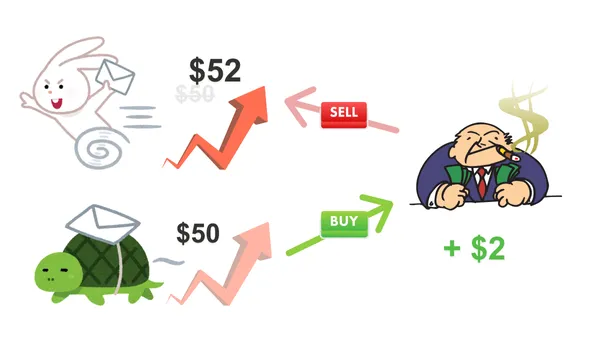What is Temporal Arbitrage?
Temporal Arbitrage is a strategy focused on short-term price fluctuations in the market, widely used in foreign exchange margin trading. Its core lies in quickly seizing price movements in different time periods to execute immediate buy and sell operations, achieving stable returns. This article will comprehensively analyze the application techniques of Temporal Arbitrage, from basic concepts, practical operations to risk management, helping traders remain undefeated in the foreign exchange market.Core Concept of Temporal Arbitrage
The essence of Temporal Arbitrage is to trade based on the fluctuations or delays in market quotes within a very short time. For example, during the transition period when the Asian market closes and the European market opens, liquidity increases, and exchange rates usually experience significant volatility. Traders can find arbitrage opportunities in these fluctuations and quickly complete buy and sell operations.In simple terms: Temporal Arbitrage transforms "time differences" into "price differences" and uses rapid trading to earn profits.
Operational Process of Temporal Arbitrage
Here are the key steps to achieve Temporal Arbitrage:- Identify Target Currency Pairs Choose popular currency pairs with higher volatility, such as EUR/USD, GBP/USD, or USD/JPY.
- Track Market Events Pay attention to upcoming economic data releases (such as GDP, non-farm payroll data) or breaking news, as these events often trigger short-term price movements.
- Analyze Short-term Fluctuations Use technical analysis tools (such as RSI, Bollinger Bands) to determine the direction and magnitude of price movements, ensuring the accuracy of trading decisions.
- Execute Rapid Trades Execute buy and sell operations simultaneously at the moment price fluctuations occur to lock in arbitrage profits.
- Calculate Trading Costs Ensure that there is still profit potential after considering spread, fees, and slippage.
Case Analysis: Application Scenarios of Temporal Arbitrage
Case 1: Arbitrage from Economic Data Releases
- When U.S. non-farm payroll data is about to be released, market volatility is expected to increase. Traders can prepare trading plans in advance to take advantage of the price differences at the moment of data release.
Case 2: Cross-Time Zone Trading Arbitrage
- During the overlap between the early session of the Asian market and the opening of the European market, liquidity significantly increases, often resulting in short-term price fluctuations, which traders can exploit for profit.

Case 3: Arbitrage from Sudden News Events
- When a central bank unexpectedly announces a change in interest rates, the market may experience price fluctuations for a few seconds, providing excellent operational space for Temporal Arbitrage.
Advantages of Temporal Arbitrage
- Fast Return Speed Temporal Arbitrage typically completes trades within seconds or minutes, suitable for traders seeking high turnover rates.
- Low Risk Trading based on market price inconsistencies carries lower risk compared to directional trading.
- High Flexibility Traders can flexibly adjust arbitrage strategies based on market conditions to adapt to different market fluctuations.
Challenges and Risk Management of Temporal Arbitrage
Although Temporal Arbitrage is efficient, it also presents certain challenges and risks:- Slippage and Execution Delays Short-term price fluctuations may lead to slippage risk, where the execution price may deviate from the expected price.
- High Trading Costs Frequent trading can incur higher fees or spread costs, potentially eroding arbitrage profits.
- Unpredictability of Market Volatility While market events create opportunities, sudden fluctuations may also increase uncertainty, necessitating effective risk control.
Practical Tools and Strategies
- Automated Trading Systems Use algorithmic trading tools (such as MetaTrader or professional algorithmic trading software) to ensure rapid execution of trades and reduce delays from manual intervention.
- Technical Analysis Indicators Utilize technical tools such as Bollinger Bands, moving averages, and RSI to identify trends in short-term price fluctuations.
- Real-time Market Data Updates Ensure the use of trading platforms that support real-time updates to avoid missing arbitrage opportunities due to data delays.
- Set Stop Loss and Take Profit Points Develop a risk control plan, setting reasonable stop loss and take profit points to prevent losses from sudden market events.
Conclusion
Temporal Arbitrage is an efficient strategy in foreign exchange margin trading. By quickly capturing short-term market fluctuations, traders can achieve stable returns. However, successful Temporal Arbitrage requires precise market analysis, rapid execution capabilities, and comprehensive risk management.I hope this article helps you master the core techniques of Temporal Arbitrage and improve trading performance through practical experience. If you are seeking breakthroughs in foreign exchange trading, Temporal Arbitrage is undoubtedly one of the strategies worth exploring in depth.
Hi, We are the Mr.Forex Research Team
Trading requires not just the right mindset, but also useful tools and insights.Here, we focus on Global Broker Reviews, Trading System Setup (MT4 / MT5, EA, VPS), and Forex Trading Basics.
We personally teach you to master the "Operating Manual" of financial markets, building a professional trading environment from scratch.
If you want to move from theory to practice:
- Help share this article to let more traders see the truth.
- Read more articles on Broker Tests and Forex Education.





